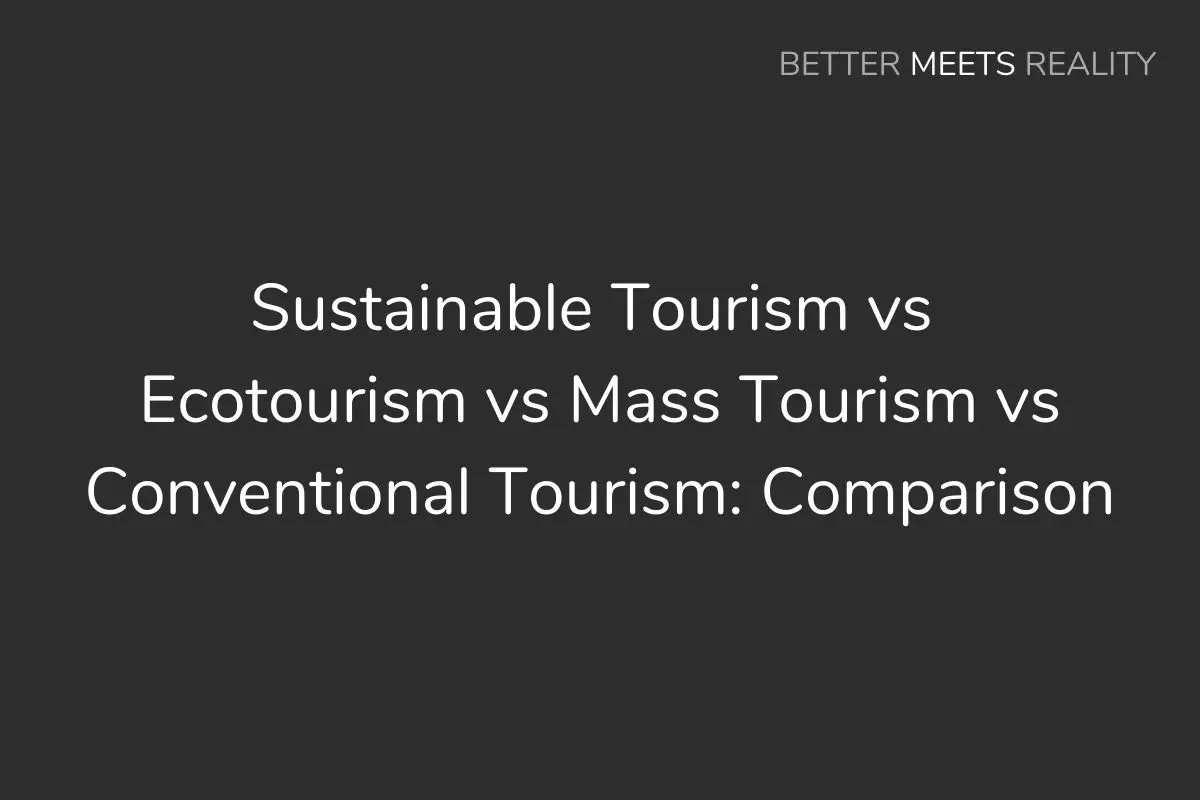In this guide, we compare the main types of tourism – what they are, and differences between them.
Those types of tourism are sustainable tourism, ecotourism, mass tourism, and conventional tourism.
Comparison & Summary – Sustainable vs Eco vs Mass vs Conventional Tourism
– Sustainable Tourism
Involves economic, social and environmental considerations
– Ecotourism
Involves environmental, ecosystems, and wildlife considerations
– Mass Tourism
Involves the primary goal of making money for the tourism service provider, and the primary goals of experience, recreation and satisfying individual needs/wants by the tourist paying for the service.
Can involve mass numbers of tourists buying standardized commercial products/services.
There’s less of an emphasis, and sometimes no emphasis on sustainability.
– Conventional Tourism
Can involve mass tourism, but also includes non mass tourism in the form of custom and niche tourism too.
Conventional tourism may or may not have similar outcomes to mass tourism.
What Is Sustainable Tourism?
Sustainable tourism considers the short term and long term economic, social and environmental impact of tourism on all tourism stakeholders.
Examples Of Sustainable Tourism
Economic
– Aim to keep more money spent in tourism within the local economy, so that the local economy can sustain itself and even grow
Environment
– Prevent tourism destinations from experiencing critical levels of environmental degradation
This is especially important for attractions that are home to important ecosystems, biodiversity or wildlife
Social
– Consider the needs, rights, and authentic culture of the locals within a geographic area that experiences tourism.
For example, the impact of waste generation on a tourist area, and the experience of the local that have to live there if waste management is poor
Another might be that local decision makers should consider the impact that resource use by tourists has on the local population if certain resources are scarce
What Is Ecotourism?
Ecotourism is a specialized concept of tourism placing specific emphasis on the short term and long term impact of tourism on the environment, ecosystems and wildlife.
It might aim to protect, or even expand environmental sites.
Ecotourism is included under the overall concept of sustainable tourism.
Examples Of Ecotourism
A few examples of ecotourism might be:
– A tourism service that helps preserve and protect a tropical rainforest
– A tourism service that helps run an ethical wildlife park or reserve
– A tourism service that helps preserve and protect an area with important biodiversity
What Is Mass Tourism?
Mass tourism includes but isn’t limited to:
– Tourism service/product providers maximizing financial gain as a primary goal (usually by servicing as many customers as possible, or by maximizing profits)
– Tourism consumers having recreation, experience, and individual needs and wants as a primary goal
– Large quantities of people usually buying the same standardized commercial tourism products and services, and primarily visiting the same tourism sites and destinations, or using the same tourism services
There’s usually little or no emphasis on sustainability with mass tourism.
Environmental degradation, and a lack of long term social and economic planning by local decision makers might be common to mass tourism
Issues that might be common to mass tourism might include:
Overcrowding, over saturation, congestion and large numbers of people and tourism products and services in one geographic area
Increased burden on local community, environment, and public services and infrastructure
A worser quality experience for tourists, and a worser daily quality of life experience for local residents
Short term profit focussed developments that become a long term liability
Leakage (of money spent in a tourism destination that leaks out of the local economy)
Hotels can be big users of water in water scarce places – resource sustainability concerns
Tourism in places with poor waste management can compound an existing issue
A host of environmental issues
Examples Of Mass Tourism
A few examples might include:
– Commercial/mass bus tours
– Commercial cruise ship/cruise liner trips
– Mass travel to, and overcrowding (quantity and density of people) of popular tourism destinations and sites
A real life example of mass tourism might be Venice in Italy – it attracts millions of visitors each year
What Is Conventional Tourism?
Conventional tourism is considered by some to be mass tourism, but, conventional tourism in reality can also involve tourism that doesn’t include mass production and consumerism.
Conventional tourism can include mass tourism, but can also include other types of tourism like personally planned, custom or niche tourism.
Consumers in particular might be looking for a specific type of trip or experience that takes their individual preferences into account.
Examples Of Conventional Tourism
A few examples might include:
– Mass tourism related activities
– Niche trips to rural areas to see historic sites of personal importance, or to experience local products and services like local food and beverages
– Planning and going on a custom travel trip not offered by, or purchased through a popular travel service provider
– Visiting family and/or friends domestically or overseas as part of a travel trip
Sources
1. Various ‘Better Meets Reality’ guides
','' ); } ?>